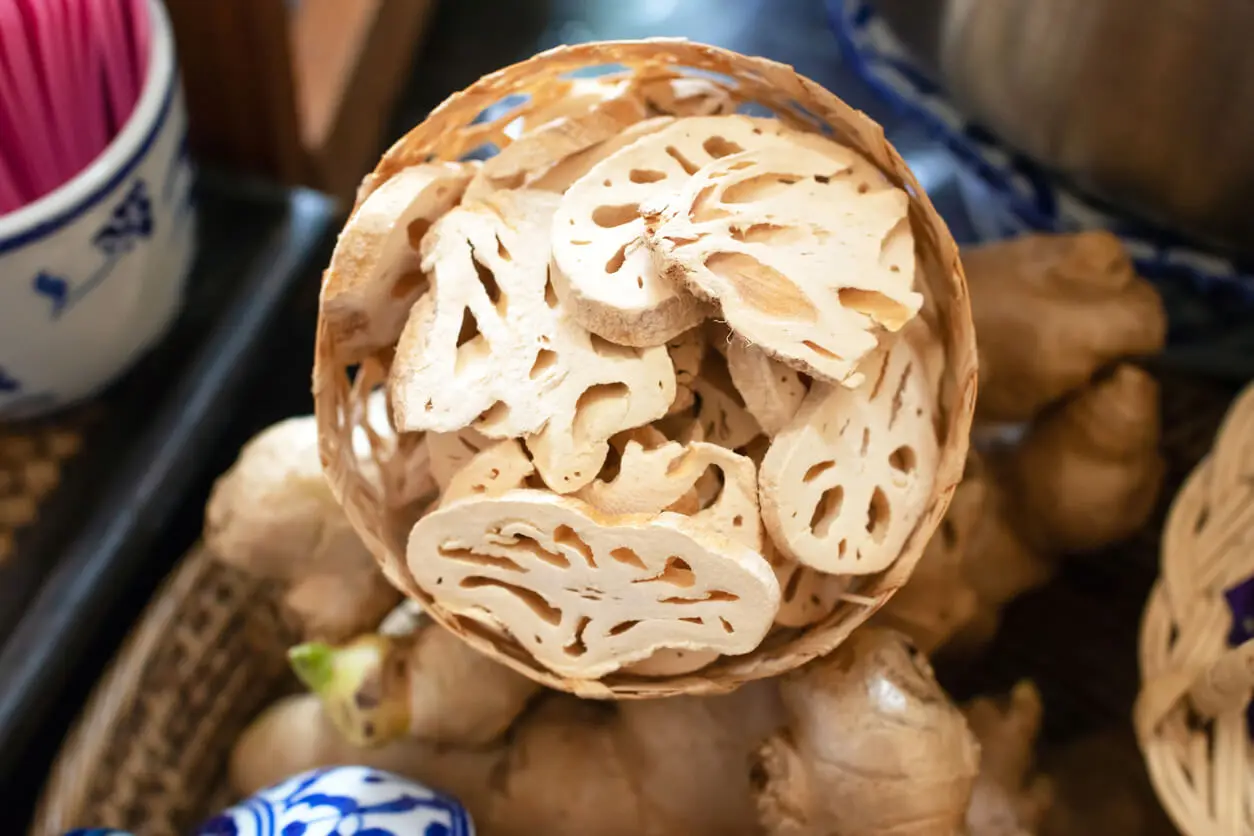Lotus Root: Nutritional Composition, Benefits and Preparation


Written and verified by the nutritionist Maria Patricia Pinero Corredor
Lotus root (Nelumbo nucifera Gaertn) is an aquatic rhizome that’s used as a staple food in many Asian countries. Its plant is recognized due to its famous flowers and is cultivated in China, Japan, and India. The beauty of its flower has given it ornamental purposes, but the root has highlighted it as a food for medicinal purposes.
This root is also called renkon and has been revered as an ingredient by various cultures. In China, its country of origin, it’s frequently used for its supposedly inexhaustible vital energy.
In gastronomy, its sensory characteristics allow it to be used in different dishes: soups, salads, snacks, and even main courses. Would you like to know more about this interesting root?
What is lotus root?
Lotus root is the rhizome of the aquatic flower Nelumbo nucifera that’s cultivated in China, Indonesia, and Japan, where it’s considered a sacred plant and a legendary food. These civilizations used it because, according to them, it enhanced and benefited health.
As a vegetable, it’s quite attractive. It has an elongated shape that measures 15 centimeters (6 inches) long. The rhizomes are attached to each other as if they were a chain of rigid roots. When cut, in the central part there are many air chambers that show a delicate pattern.
Currently, science is studying it due to its extensive benefits and nutritional properties that we’ll develop below.
Read more here: The Difference Between Tubers, Tuberous Roots, and Bulbs
Nutritional composition
According to Xu Wang, lotus root is rich in starch, fiber, protein, vitamins, and minerals. On the other hand, it also contains flavonoids, alkaloids, and other bioactive substances related to good health.
The main nutrients contained in 100 grams (4 oz) of raw lotus root are as follows:
- Protein: 2.34 grams.
- Fat: 0.14 grams.
- Total carbohydrates: 8.81 grams.
- Fiber: 0.80 grams.
- Calories: 46.
- Vitamin C: 15 milligrams.
- Potassium: 2400 milligrams.
- Calcium: 150 milligrams.
- Iron: 13.50 milligrams.
- Phosphorus: 804 milligrams.
- Zinc: 5.08 milligrams.
The caloric value of this root makes it recommended for low-energy diets. A raw portion of 100 grams (4 oz) gives us only 46 calories, which come from the moderate starch content and its proteins.
On the other hand, the speed with which its carbohydrates are absorbed is 33. The glycemic load is 3, which makes it a low glycemic index root.
Lotus root also stands out for its high mineral value. Potassium, iron, phosphorus and zinc distinguish it among other common roots.
Recent research found that the best method for preserving the minerals and vitamin C in lotus root is steaming. Frying and boiling significantly decrease the content of both nutrients.

Lotus root benefits
Lotus root contains a good amount of potent antioxidants such as flavonoids, alkaloids, and other bioactive substances. So, it’s a very healthy addition to our diets.
Source of antioxidants
In the journal Molecules they explain that, out of 36 selected vegetables, lotus root exhibited the highest antioxidant activity. The most frequent phenolics in it are gallic acid, catechin, epicatechin, chlorogenic acid, catechol, and gallocatechin.
The parts that contain most of them are the peel and the nodes of the root. This is why they’re recommended for consumption and as nutraceuticals. The presence of these compounds reduces cellular oxidative stress and stops the progression of some chronic diseases.
Astringent and diuretic effect
An aqueous extract of lotus root showed a diuretic effect and astringent properties during the treatment of obesity. In animal experiments, it was observed that the water loss achieved with the root resulted in a significant decrease in body weight gain.
Antifungal
A group of experts evaluated lotus rhizome for the treatment of Candida albicans, Aspergillus niger, A. fumigatus, and Trichophytum mentagopyhtes. It was found capable of preventing growth in these fungi and yeasts. In addition, it was more effective than classical drugs.
Antidiabetic and glycemia-regulating effect
In the journal Journal of Ethnopharmacology, the stimulating effect of insulin secretion from nuciferin was published. This substance is found in high concentrations in lotus root and acts on the beta cells of the pancreas. This is why it’s considered for its anti-diabetic effect.
Other studies have also reported that lotus rhizomes contain alkaloids, tannins, glycosides, flavonoids, saponins, and steroids that inhibit pancreatic alpha amylase. This enzyme is responsible for breaking down the starch molecule in food into sugars.
The inhibitory effect of phytochemicals offers an effective strategy for lowering high blood glucose levels after meals.
Antithrombotic property
Zhou and other researchers found that neferin, a substance found in lotus root, prevents thrombus formation. The mechanism involves inhibition of platelet activation, adhesion, and aggregation.
Hepatoprotective
In a laboratory test, the hepatic protective effect of a hot water extract of lotus root supplemented with taurine was determined. The findings revealed that administration of the extract significantly increased the activity of hepatic antioxidant enzymes, protecting the livers of obese rats.
Benefits for heart health
One of the most plentiful nutrients in lotus root is potassium. Half a cup of boiled root can meet 10% of the adult requirement. Potassium helps regulate blood pressure. Together with vitamin C, it can prevent heart disease.

May help treat nasal allergies
Studies conducted on mice show that lotus root powder could decrease the symptoms of nasal allergy. The sensitized mice showed more anti-inflammatory effects in response to allergens.
Read more here: What Is Nasal Mucus and What Does It Do?
Preparation of the lotus root
Like any other vegetable, the lotus root gives us many options to prepare it. It can be boiled, eaten raw, put in soups, or fried.
The first thing is to peel it with a knife or potato peeler. Then cut it into thin slices and, if you don’t use them immediately, then you should put it in water with a splash of lemon juice or vinegar.
The high content of flavonoids activates the polyphenol oxidase of the vegetable, which, together with the oxygen, causes an enzymatic browning reaction, changing the color of the root. This is exactly the same process that occurs with avocados or potatoes.
Another option is to blanch it, placing it in boiling water with a splash of vinegar. It is passed through a strainer and cooled and then used in salads.
Its mild flavor allows it to absorb all the spices and sauces it’s prepared with. In addition, the appearance and crunchy texture make it very appetizing.
If you’re thinking about soup, then you should be careful to add it near the end of the cooking process. If you leave it too long in the broth it will gel the starch and become sticky.
Is lotus root recommended for a healthy diet?
Despite the findings found in laboratory animal experiments, more human studies are required. This will allow precise conclusions on the doses and effects of the product.
However, what has been confirmed is the varied amount of antioxidants it presents. So, all in all, you can add lotus root to your diet with total confidence!
All cited sources were thoroughly reviewed by our team to ensure their quality, reliability, currency, and validity. The bibliography of this article was considered reliable and of academic or scientific accuracy.
- Chen, S.Y. and Tengku Rozaina, T.M. Effect of cooking methods on nutritional composition and antioxidant properties of lotus (Nelumbo nucifera) rhizome. Food Research 4 (4) : 1207 – 1216 (August 2020). Journal homepage: http://www.myfoodresearch.com
- Wang, X. (2014). Preliminary assessment of lotus (Nelumbo nucifera Gaertn) rhizomes: An underutilized aquatic vegetable crop. Alabama: Auburn University. MSc. Thesis. Disponible en: https://etd.auburn.edu/bitstream/handle/10415/4338/Final%20Xu%20Wang%20Thesis%20dec%2013th%202014.pdf?sequence=2&isAllowed=y
- Yi, Y., Sun, J., Xie, J., Min, T., Wang, L. M., & Wang, H. X. (2016). Phenolic Profiles and Antioxidant Activity of Lotus Root Varieties. Molecules (Basel, Switzerland), 21(7), 863. https://doi.org/10.3390/molecules21070863
- Ohkoshi E, Miyazaki H and Shindo K: Constituents from the leaves of nelumbo nucifera stimulate lipolysis in the white adipose tissue of mice. Planta Med 2007; 73(12):1255-1259.
- Mukherjee, P.K., Mukherjee, D., Maji, A.K., Rai, S.R., & Heinrich, M. (2009). The sacred lotus (Nelumbo nucifera)– phytochemical and therapeutic profile. Journal of Pharmacy and Pharmacology, 61. Disponible en: https://www.semanticscholar.org/paper/The-sacred-lotus-(Nelumbo-nucifera)%E2%80%93-phytochemical-Mukherjee-Mukherjee/edd7d499ce64022b735d8d1985161ce3fca86d90
- Nguyen KH, Ta TN, Pham TH, Nguyen QT, Pham HD, Mishra S and Nyomba BL: Nuciferine stimulates insulin secretion from beta cells-a comparison with glibenclamide. J Ethnopharmacol 2012; 142(2):488-95. Disponible en: https://www.sciencedirect.com/science/article/abs/pii/S0378874112003340
- Zhou YJ, Xiang JZ, Yuan H, Liu H, Tang Q, Hao HZ, Yin Z, Wang J and Ming ZY: Neferine exerts its antithrombotic effect by inhibiting platelet aggregation and promoting dissociation of platelet aggregates. Thromb Res 2013; 132(2): 202-10.
- Sohn DH, Kim YC and Oh SH. Hepatoprotective & free radical scavenging effects of Nelumbo nucifera. Phytomedicine 2003; 10(2-3):165-169. Disponible en: https://www.semanticscholar.org/paper/Hepatoprotective-and-free-radical-scavenging-of-Sohn-Kim/063617192b9a216c4eb5fe06c707da3b949b8be7
- Ponnusamy S, Ravindran R, Zinjarde S, Bhargava S and Ravi Kumar A: Evaluation of traditional indian antidiabetic medicinal plants for human pancreatic amylase inhibitory effect in vitro. Alternat Med 2011; Article ID 515647.
- The University of Sidney. Glycemic Index Research and GI News. Disponible en: https://glycemicindex.com/foodSearch.php?num=1934&ak=detail
- Heart.org. How to Eat More Fruit and Vegetables.Disponible en: https://www.heart.org/en/healthy-living/healthy-eating/add-color/how-to-eat-more-fruits-and-vegetables
- Mayumi Kaneyasu, Maki Nagata, Hiromi Ikeda, Koichiro Ohnuki, Kuniyoshi Shimizu. Anti-allergic activity of lotus root (Nelumbo nucifera) powder in TDI-sensitized nasal allergy model mice. Food and Agricultural Immunology , Volume 30, 2019 – Issue 1. https://doi.org/10.1080/09540105.2019.1651255
This text is provided for informational purposes only and does not replace consultation with a professional. If in doubt, consult your specialist.








